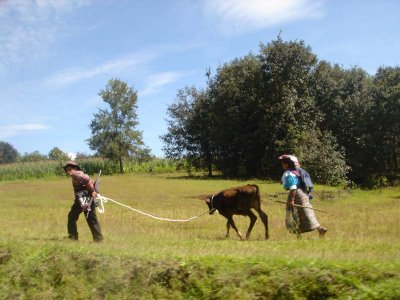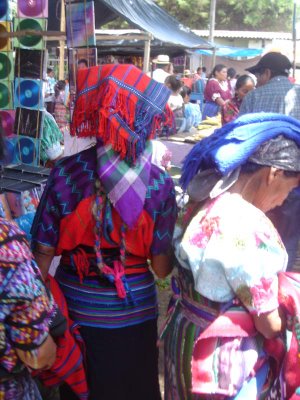
Since I got back to Chiché a sense of well-being has been blossoming within me. At the moment I am loving being here. The projects are producing fantastic results; I feel truly integrated into the community and I am getting to know surrounding parts of Quiché, which is such a beautiful region. Last Sunday I boarded the bus to Joyabach, the end of the chicken bus line which runs from Santa Cruz del Quiché and through Chiché and is also where the paved road ends. I attended the Sunday “plaza” (market), which was a sight worth seeing. Being the only substantially sized town in a very rural area, this market attracts thousands from the surrounding communities and beyond. I got waylaid by a cluster of beautiful young girls who showed me around the market and introduced me to their market-vending families. I got to know a fruit seller and discussed the politics posed by the enormous influence of the USA facing countries such as Guatemala. He, like so many thousands of Latin Americans, has spent several years in the US, having paid $6000 to a coyote to cross the border. Some stories of crossing the border are horrendous, involving trials of endurance, thirst and extreme hardship. Not only has the US recently initiated severe restrictions facing illegal immigrants, they have just announced a proposal to spend over three thousand million dollars building an “invisible” barrier along both the Mexican and Canadian borders consisting of security towers with extremely high-tech surveillance, basically ensuring the borders are impenetrable.

In my mind this heralds the beginning of a super-technological, super-defended, paranoic world like those represented in any number of futuristic movies, where basically the importance of humans is left behind in the bid for power. ¡Que triste! This blocking of the border will affect the Latin population immensely, as a huge percentage of every Hispanic nation lives and works in the US, usually illegally, providing the money that their families live on back home and also creating a labour force the US relies on. If you get the chance, rent the movie “The day the Mexicans disappeared” (called something like that). It is a bit shallow, but quite funny, basically demonstrating what happens in California without its latino population.

Life is hard here. Guatemala has one of the highest rates of poverty in Latin America, and as I become closer to local families, I am understanding so much more about their lives and social situation. I feel so privileged to have been embraced by such wonderful people. They make me feel as if I have touched their hearts as they have touched mine. I love the friendliness here. It would be rude to pass someone on the street without offering a greeting. When was the last time that happened to you in London or wherever you are? I will miss that, as I will miss so many things about being here.


Last week I went to visit a friend in Sacapulas, a pretty little town nestling at the bottom of a huge open valley which dwarfs the town, especially when viewed from way up high on the ascending road to Nebaj. This road is breathtakingly beautiful in proper Quiché form, with rolling hills carpeted with elegant pine; the greenness impossibly intense at this time of year. The September rains have tardied this year, but now are well and truly under way. Rain in Sacapulas is a blessing, as it is hot due to its low altitude. Coconut palms and banana trees abound, the Rio Negro offering a treat in the form of pools of natural hot springs all along its banks. I was most warmly welcomed by Dominga, a señora I met at a party in Chiché, and her entire extended family. The traditional Sacapulas traje is flamboyant, and within 5 minutes of arriving I was learning how to dress my head with the elaborated “cinta” consisting of several metres of gorgeous woven braid with huge fluffy pompoms at either end. We had a cinta-dressing session with all the women in the house and I was presented with my own huipil (blouse) and corte (skirt). I bought a cinta and then wore my traje for the rest of my time in Sacapulas, which caused quite a sensation with the locals! What fun and what wonderful people!




0 Comments:
Post a Comment
<< Home